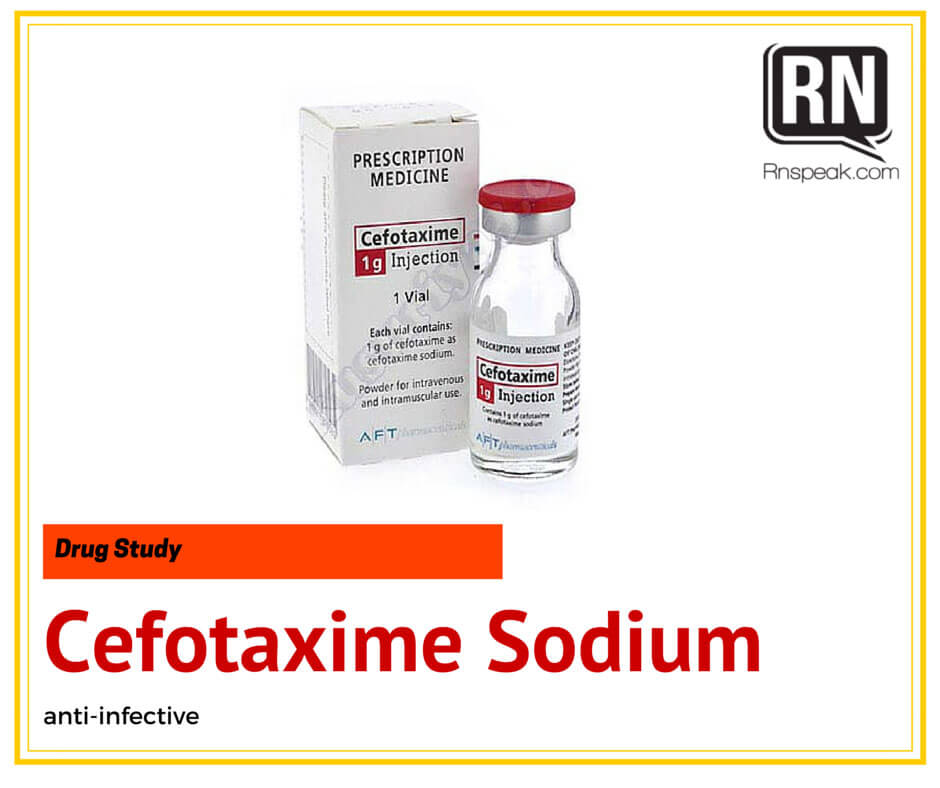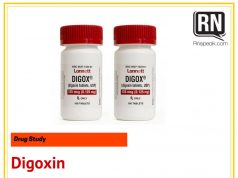
Generic Name: Cefotaxime Sodium
Brand Name: Claforan
Classifications:antiinfective; beta-lactam antibiotic; third-generation cephalosporin
Pregnancy Category:B
Availability 500 mg, 1 g, 2 g injection
Actions
Broad-spectrum semi-synthetic third-generation cephalosporin antibiotic. Preferentially binds to one or more of the penicillin-binding proteins (PBP) located on cell walls of susceptible organisms. This inhibits third and final stage of bacterial cell wall synthesis, thus killing the bacterium.
Therapeutic effects
Generally active against a wide variety of gram-negative bacteria including most of the Enterobacteriaceae. Also active against some organisms resistant to first and second generation cephalosporins and currently available aminoglycoside antibiotics and penicillins, e.g., Escherichia coli, Klebsiella pneumoniae, and Serratia marcescens. Other susceptible organisms: Bacteroides fragilis, Morganella morganii, Proteus mirabilis, Salmonella, Shigella, Hemophilus influenzae, Neisseria gonorrhoeae, groups A and B Streptococci, Staphylococcus aureus, Bacteroides, Eubacterium, Peptostreptococcus, and Peptococcus. Inhibits some strains of Clostridium, but C. difficile is resistant to the drug, as is Listeria monocytogenes. It is the drug of choice in the treatment of gram-negative adult bacillary meningitis, neonatal and childhood meningitis, and Enterobacteriaceae. Effectively treats bone and joint infections, CNS infections, gynecologic infections and gonorrhea, lower respiratory tract infections, intra-abdominal infections, skin and urinary tract infections, and is used for surgical prophylaxis to reduce or eliminate infection.
Uses
Serious infections of lower respiratory tract, skin and skin structures, bones and joints, CNS (including meningitis and ventriculitis), gynecologic and GU tract infections, including uncomplicated gonococcal infections caused by penicillinase-producing Neisseria gonorrhoeae (PPNG). Also used to treat bacteremia or septicemia, intra-abdominal infections, and for perioperative prophylaxis.
Contraindications
Hypersensitivity to cephalosporins and other beta-lactam antibiotics; pregnancy (category B).
Cautious Use
History of type I hypersensitivity reactions to penicillin; history of allergy to other beta-lactam; antibiotics; renal impairment; history of colitis or other GI disease; lactation.
Route & Dosage
Moderate to Severe Infections
adult:IV/IM 1–2 g q8–12h, up to 2 g q4h (max 12 g/d)
child:IV/IM <=1wk: 50 mg/kg q12h; 1–4 wk: 50 mg/kg q8h; 1 mo–12 y: 100–200 mg/kg/d divided q4–8h
Surgical Prophylaxis
adult:IV/IM 1 g 30–90 min before surgery
Administration
Intramuscular
- Add 3 mL sterile water for injection or bacteriostatic water for injection to vial containing 1 g drug, providing a solution of approximately 300 mg cefotaxime/mL.
- Administer IM injection deeply into large muscle mass (e.g., upper outer quadrant of gluteus maximus). Aspirate to avoid inadvertent injection into blood vessel. If IM dose is 2 g, divide dose and administer into 2 different sites.
- Risk of phlebitis may be reduced by use of a small needle in a large vein.
Intravenous
- IV administration to infants and children: Verify correct IV concentration and rate of infusion with physician.
- Do not admix cefotaxime with sodium bicarbonate or any fluid with a pH > 7.5.
PREPARE direct: Add 10 mL diluent to vial with 1 or 2 g drug providing a solution containing 95 or 180 mg/mL, respectively. intermittent: To 1 or 2 g drug add 50 or 100 mL D5W, NS, D5/NS, D5.45% NaCl, RL or other compatible diluent. continuous: Dilute in 500–1000 mL compatible IV solution.
ADMINISTER direct: Give over 3–5 min.intermittent: Give over 20–30 min, preferably via butterfly or scalp vein-type needles. continuous: Infuse over 6–24 h.
Adverse Effects
BodyWhole:Fever, nocturnal perspiration, inflammatory reaction at IV site, phlebitis, thrombophlebitis; pain, induration, and tenderness at IM site, superinfections.
GI:Nausea, vomiting, diarrhea, abdominal pain, colitis, pseudomembranous colitis, anorexia.
Metabolic:Transient increases in serum AST, ALT, LDH, bilirubin, alkaline phosphatase concentrations.
Skin:Rash, pruritus.
Nursing Implications
Assessment & Drug Effects
- Determine previous hypersensitivity reactions to cephalosporins and penicillins, and history of other allergies, particularly to drugs, before therapy is initiated.
- Lab tests: Perform culture and sensitivity tests before initiation of therapy and periodically during therapy if indicated. Therapy may be instituted pending test results. Serum creatinine, creatinine clearance, BUN should be evaluated at regular intervals during therapy and for several months after drug has been discontinued. Perform periodic hematologic studies (including PT and PTT) and evaluation of hepatic functions with high doses or prolonged therapy.
- Monitor I&O rates and patterns: Report change in I&O in patients with impaired renal function or with chronic UTI or who are receiving high dosages or an aminoglycoside concomitantly.
- Superinfection due to overgrowth of nonsusceptible organisms may occur, particularly with prolonged therapy.
- Report onset of diarrhea promptly. Check for fever. If diarrhea is mild, discontinuation of cefotaxime may be sufficient.
- If diarrhea is severe, suspect antibiotic-associated pseudomembranous colitis, a life-threatening superinfection (may occur in 4–9 d or as long as 6 wk after cephalosporin therapy is discontinued). Chronically ill or debilitated older adult patients undergoing abdominal surgery or those in an intensive care unit are most vulnerable.
Patient & Family Education
- Report any early signs or symptoms of superinfection promptly. Superinfections caused by overgrowth of nonsusceptible organisms may occur, particularly during prolonged use.
- Yogurt or buttermilk, 120 mL (4 oz) of either (if allowed), may serve as a prophylactic against intestinal superinfection by helping to maintain normal intestinal flora.
- Report loose stools or diarrhea.
- Do not breast feed while taking this drug without consulting physician.







